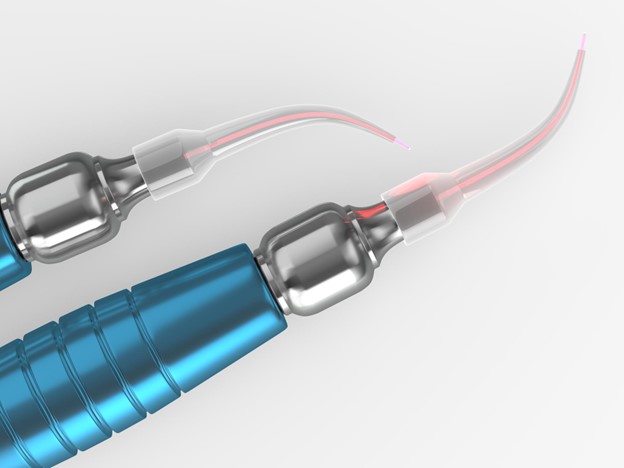Although the term “root canal” is associated with discomfort for some, the power of laser endodontics can make a root canal treatment more comfortable and precise. If you have a tooth that is bothering you, believe you could benefit from root canal therapy, and live in Oakbrook Terrace, IL, book a consultation at Gallery Dental of Oakbrook. Dr. Peter Noto can determine if you need a root canal and apply laser endodontics.
Keep reading to learn why and how laser endodontics is performed and some advantages of this advanced treatment.
Why do dentists perform root canal therapy?
The innermost area of a tooth is called the pulp. When a tooth is severely decayed or damaged, the pulp is at risk of experiencing pulpitis (inflammation and infection in the dental pulp). Often, pulpitis occurs when the enamel and dentin (the protective layers of the tooth) are destroyed, leaving the delicate tooth root exposed.
When pulpitis occurs, and the tooth is still salvageable, your dentist might suggest root canal therapy to save as much dental structure as possible. The primary purpose of root canal therapy is to remove infected tissue within a severely damaged tooth.
What are the signs that a root canal may be necessary?
If you suspect pulpitis, seek prompt treatment. Because if you wait too long, your dentist must extract the severely infected tooth. Here are some common signs of pulpitis:
- Bad breath
- A foul taste in the mouth
- Swelling and discomfort around the tooth
- Dental sensitivity
- Swollen lymph nodes
- Fever
How are root canals traditionally performed?
For centuries, dentists have employed drills and other dental tools to reliably remove infected or damaged pulp from a severely decayed tooth. The affected area is disinfected and sealed. After the infection is cleared, the dentist puts a permanent filling or dental crown on the tooth.
How does laser endodontics improve root canal therapy?
Laser endodontics combines conventional root canal therapy techniques with laser technology to effectively exterminate bacteria and infected pulp. This method prevents reoccurring infections.
Dentists use a laser drill to access the inner chamber during laser endodontics treatment and a soft-tissue laser to sterilize dental structures. For example, laser endodontics can easily reach the dentinal tubes, which are challenging to reach with traditional root canal therapy.
What are some advantages of laser endodontics?
Laser endodontics provides a more precise and effective way to treat infected tooth pulp. While carefully chiseling away at infected or damaged dental pulp, laser endodontics reduces damage to as much healthy dental structure as possible.
Time is a valuable commodity, and using lasers during root canal therapy typically reduces overall treatment time. Generally, less friction is involved with laser endodontics—leading to more comfort throughout your procedure. Plus, patients experience minimal post-operative swelling and discomfort with laser endodontics.
Find Out More About Laser Endodontics in Oakbrook Terrace, IL
From detecting cavities to annihilating harmful bacteria, laser endodontics technology can treat a variety of common dental problems with ease. At Gallery Dental of Oakbrook, Dr. Noto uses lasers for root canal therapy since the speed, precision, and recovery are considerably better than conventional treatment methods. Our experienced dental team is committed to delivering services that exceed your expectations, so call (630) 620-8300 or message him online to feel the superiority of laser endodontics.
